My Son Vietnam, located in Duy Phu commune, Duy Xuyen district, Quang Nam province, beckons travelers to explore its enchanting world. As a UNESCO World Heritage Site, this ancient temple complex holds profound historical and cultural significance. Join us on a journey to uncover the secrets of My Son Vietnam, nestled amidst lush hills and steeped in Champa heritage.
See more: Discover Vibrant Vietnamese Culture on Your Adventure
Exploring My Son Vietnam: A Guide to the Ancient Temple Complex
Nestled within the mountainous border of Duy Xuyen District in Quang Nam Province, central Vietnam, lies the awe-inspiring My Son Sanctuary. Dating back from the 4th to the 13th centuries CE, this remarkable site boasts a rich history deeply rooted in the cultural heritage of the Champa civilization.

Historical and Architectural Marvel
My Son Sanctuary stands as a testament to the unique culture that flourished along the coast of contemporary Vietnam during the Champa Kingdom’s reign. Over ten centuries of continuous development, the ruling Dua Clan unified the Cham clans, establishing Champapura, the religious and political capital. The sanctuary’s tower temples, constructed during this period, showcase a blend of Hindu and Cham architectural styles.
Spiritual and Cultural Significance
At the heart of My Son Sanctuary lies a profound spiritual significance, deeply intertwined with Hinduism. Dedicated to Hindu divinities such as Krishna, Vishnu, and above all, Shiva, these temples served as places of worship and reverence. The architectural designs of the tower temples symbolize the grandeur and purity of Mount Meru, the mythical sacred mountain of Hindu gods, replicated on Earth in the Cham people’s mountainous homeland.
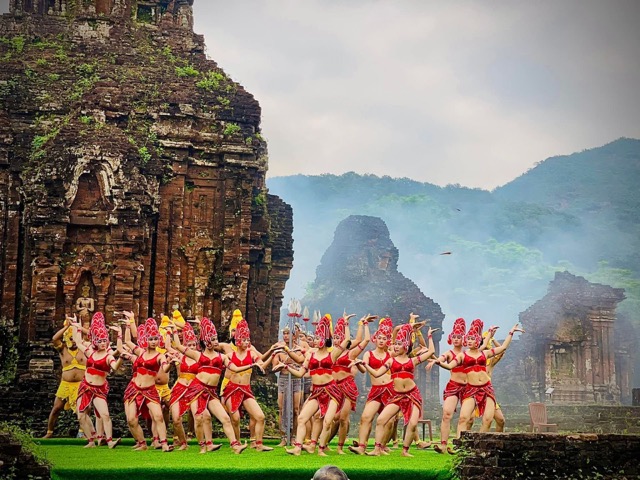
Preservation Efforts and Ongoing Research
Despite the passage of time and natural elements, preservation efforts at My Son Vietnam remain steadfast. The intricate sandstone bas-reliefs, depicting scenes from Hindu mythology, stand as a testament to the Cham people’s engineering prowess and artistic expression. Ongoing research endeavors provide invaluable insights into Cham religious and political thought, offering a vivid picture of spiritual and political life in Southeast Asia during this crucial phase of history.
If you are a history enthusiasts, explore Top 5 Vietnamese Tunnels: Worthwhile Experience for Every Traveler
Unveiling the Mysteries of My Son Temple Vietnam
Nestled amidst the picturesque landscape of central Vietnam, the temples, towers, and tombs of My Son Sanctuary stand as silent witnesses to a bygone era of spiritual and architectural excellence. Dating back from the 4th to the 13th centuries CE, this ancient complex showcases a convergence of architectural styles, reflecting the cultural and religious influences of the Champa civilization.
Religious and Symbolic Meanings
At the heart of My Son Temple lies a profound spiritual significance deeply rooted in Hinduism. The layout of the temples and towers is a testament to Indian architectural styles, with each cluster featuring a main tower (Kalan) dedicated to Linga or the image of Shiva. Surrounding these main towers are smaller sub-towers, each serving as a place of worship for directional gods. The pyramid-shaped towers symbolize the sacred Mount Meru, while intricate carvings and bas-reliefs depict scenes from Hindu mythology, offering insight into the religious beliefs and cultural practices of the Cham people.
Intricate Carvings and Architectural Styles
The temples of My Son Sanctuary boast remarkable architectural sophistication, with exquisite carvings adorning their facades. Despite the passage of time, remnants of these intricate designs still bear the golden mark of the legendary Champa dynasties. Tower clusters such as A and B showcase a variety of architectural styles, including the ancient My Son E1 style, Hoa Lai style, Dong Duong style, and Binh Dinh style. Each style reflects a unique period of cultural and artistic evolution, providing a glimpse into the rich tapestry of Champa heritage.
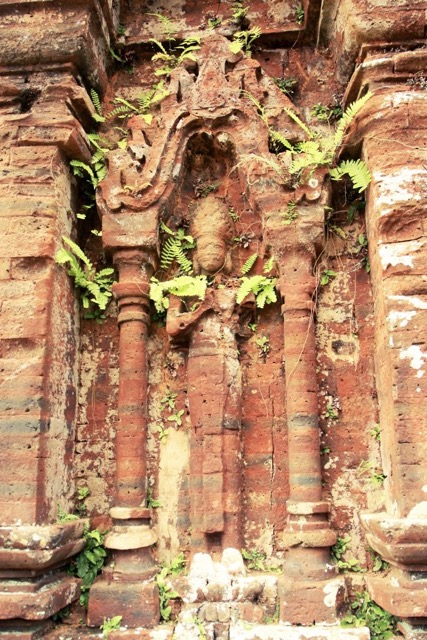
Stories and Legends
Echoes of ancient myths and legends resonate through the corridors of My Son Temple, weaving tales of gods, heroes, and mythical creatures. The temples were not only places of worship but also cultural and religious centers, where powerful kings and priests were laid to rest. Legend has it that visitors who once prayed at My Son Temple would walk around the towers clockwise, following a sacred path to seek blessings and divine protection. These stories serve as a testament to the enduring legacy of My Son Sanctuary as a sacred pilgrimage site and a symbol of spiritual devotion.
As guardians of this ancient heritage, it is our responsibility to preserve and protect My Son Temple for future generations. Despite the ravages of time and conflicts, ongoing conservation efforts seek to safeguard these architectural treasures, ensuring that the sanctity and splendor of My Son Sanctuary endure for centuries to come. Let us continue to unveil the mysteries of My Son Temple Vietnam, celebrating its rich cultural heritage and profound spiritual significance as a testament to human ingenuity and creativity.
Don’t forget to check out these Top 9 Famous Vietnamese Bridges
How to Get to My Son Vietnam: Transportation Options
Nestled in the Quang Nam province of Vietnam, My Son Sanctuary awaits eager travelers seeking to explore its ancient Cham Pa architecture and cultural heritage. While located approximately 69 kilometers from Da Nang city, and in close proximity to Hoi An, accessing this historical gem is relatively straightforward, offering various transportation options for visitors.
Reaching My Son Sanctuary
My Son Sanctuary, a UNESCO World Heritage Site nestled in the heart of Vietnam, beckons travelers with its ancient allure and architectural splendor. Situated within reach from both Da Nang and Hoi An, accessing this cultural gem is a journey filled with options tailored to suit every traveler’s preference.
From Da Nang to My Son:
- Bus: Board bus route number 06 departing from Da Nang city center. Operating daily from 5:30 a.m. to 5:00 p.m., tickets range from 8,000 to 30,000 VND per ride, providing an affordable and convenient travel option.
- Car/Motorbike: Opt for a rented car or motorbike to enjoy the freedom of the open road. Follow Highway 1 to Nam Phuoc town, then continue west on Road 537 for approximately 9km to Tra Kieu. Afterward, travel another 12km to the intersection and turn left, following signs leading to My Son Sanctuary.
- Taxi: For those seeking convenience and peace of mind, taxis offer a direct route from Da Nang to My Son Sanctuary, albeit at a higher cost.
From Hoi An to My Son:
- Motorbike: Renting a motorbike presents an adventurous option for exploring the countryside. From Hoi An, follow Hung Vuong Street to National Highway 1A, providing a scenic route to My Son Sanctuary.
- Service Vehicles: Travelers pressed for time may opt for service vehicles, offering swift transportation to My Son Sanctuary while ensuring comfort and convenience.
When to Visit My Son Sanctuary:
The most favorable time to visit My Son Sanctuary is during the dry season, from February to April. With mild temperatures and clear skies, visitors can explore the ancient ruins and lush landscapes without the hindrance of rain. Additionally, cultural performances held throughout the day provide insight into the rich history and traditions of this revered site.
Navigating My Son Vietnam: Map and Visitor Information
Upon arrival at My Son Sanctuary, visitors are greeted with a sprawling complex steeped in history and architectural splendor. To make the most of your visit, it’s essential to familiarize yourself with the site’s layout and essential visitor information.
A detailed map of My Son Sanctuary, highlighting key temples and trails, serves as a valuable guide for exploration. From the iconic tower clusters to scenic pathways, the map offers insight into the sanctuary’s architectural marvels and cultural significance.
As for visitor information, it’s important to note the ticket prices and opening hours for My Son Sanctuary. Foreigners can expect to pay 150,000 VND for admission, while Vietnamese visitors are charged 100,000 VND. The sanctuary typically opens its gates from 6:00 a.m. to 5:00 p.m. daily, providing ample time for exploration and discovery.
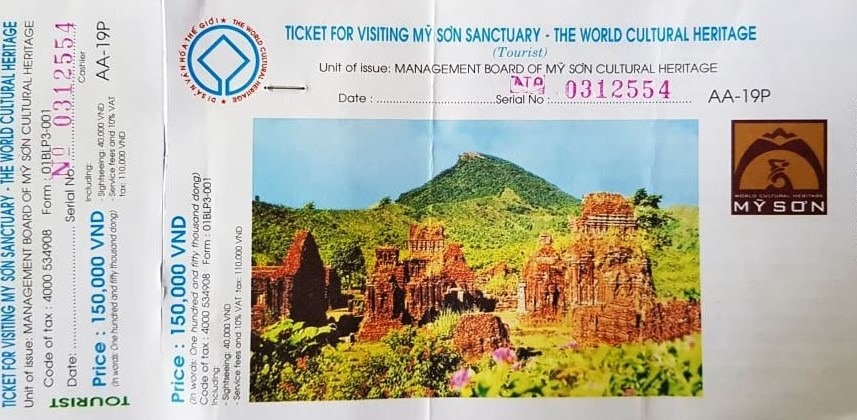
For those seeking guided tours or additional insights into the site’s history and significance, various tour options are available. Knowledgeable guides offer informative commentary, enhancing the visitor experience and providing deeper insight into My Son’s rich cultural heritage.
Additionally, recommendations for nearby accommodations, restaurants, and amenities ensure a comfortable and memorable visit to My Son Sanctuary. From cozy guesthouses to authentic dining experiences, travelers can immerse themselves in the local culture and hospitality, enriching their journey to this ancient treasure trove.
Specialties You Must Try When Visiting My Son Sanctuary
Embarking on a journey to My Son Sanctuary offers not only a glimpse into ancient Cham Pa architecture but also a culinary adventure filled with tantalizing specialties unique to the region. From savory noodles to delectable cakes, here are some must-try dishes to savor during your visit to this historical treasure trove.
Phu Chiem Noodles
Indulge in the irresistible flavors of Phu Chiem noodles, a beloved dish that combines chewy white noodles with succulent pork belly and tender shrimp bathed in a rich broth. Served alongside fresh raw vegetables and a hint of spicy chili, Phu Chiem noodles offer a symphony of flavors that will delight your taste buds.
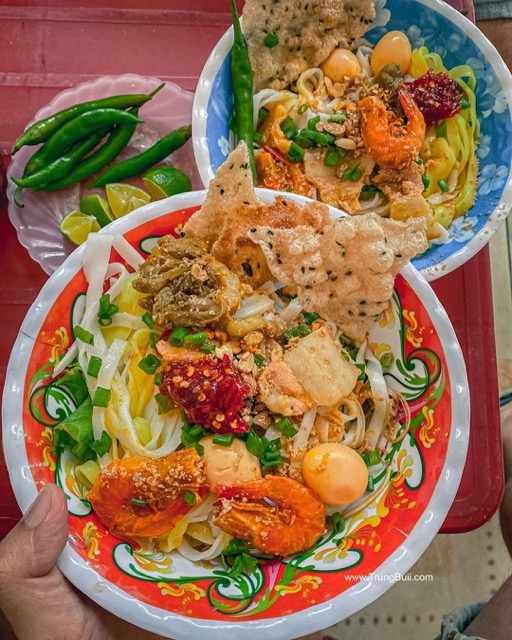
Banh Dap
Experience the delicate texture of Banh Dap, a rice paper-like delicacy available in two variations: grilled dry cake and wet cake. Dip these savory treats in pure fish sauce and a dash of fresh chili for an extra burst of flavor that will leave you craving for more.
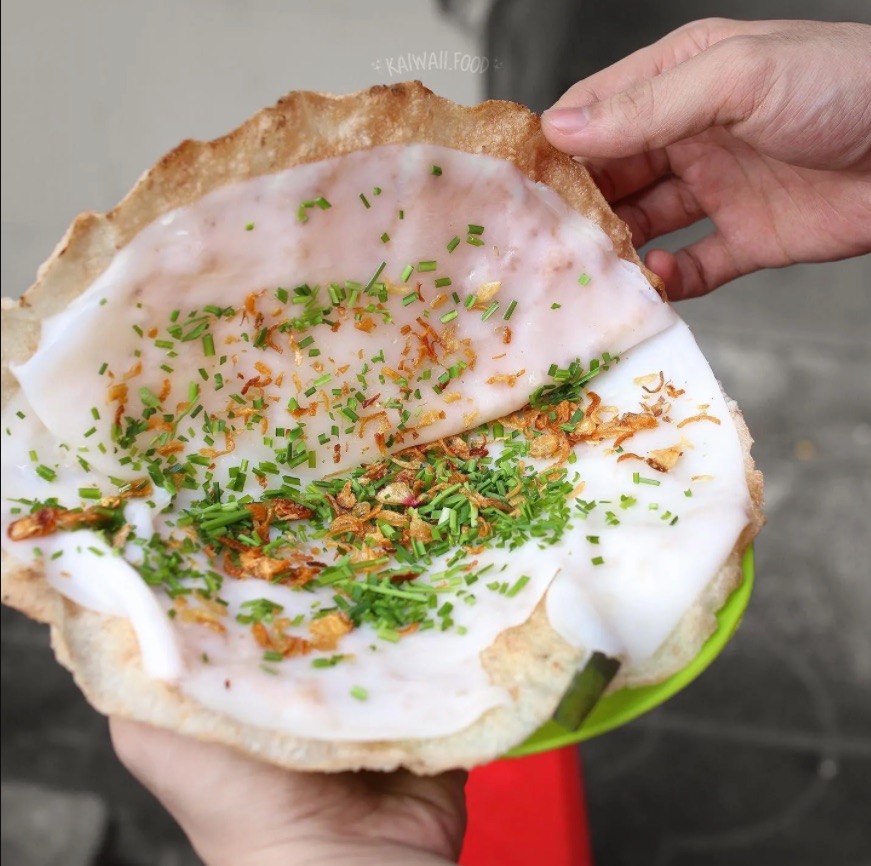
Cau Mong Veal Dish
Savor the exquisite taste of Cau Mong veal dish, featuring carefully selected veal simmered to perfection over a charcoal stove. Sliced thinly and served with dipping sauce and crisp raw vegetables, this dish is a culinary delight that promises to leave a lasting impression.
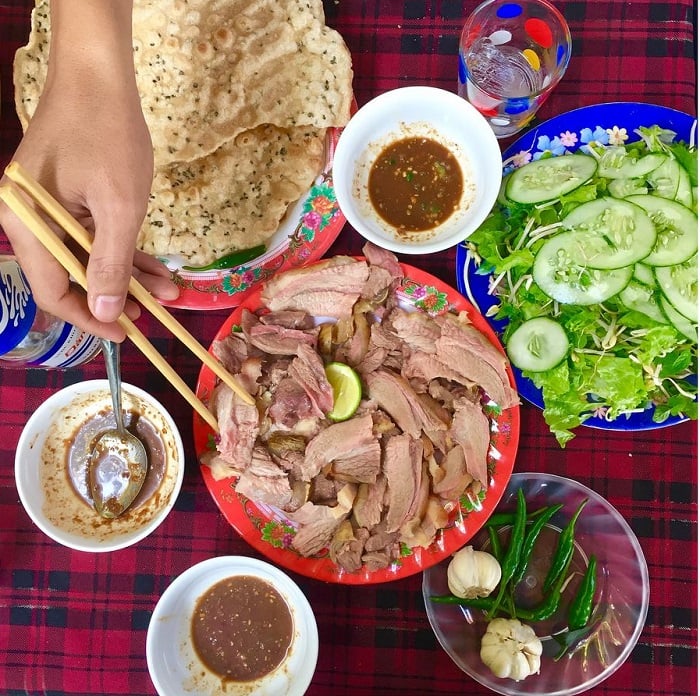
Tips for Your Visit
- As you explore the wonders of My Son Sanctuary, keep in mind these helpful tips to enhance your experience:
- Take advantage of promotional tickets for students available at the gate area.
- Respect the cultural heritage of My Son Sanctuary by refraining from performing worship or burning incense on-site.
- Consider hiring a tour guide to gain deeper insights into the history and significance of this sacred place.
- Support local businesses by shopping at the designated unit within the sanctuary.
- Catch cultural performances held at specific times throughout the day to immerse yourself in the vibrant traditions of the region.
If visiting during the months of February to April, be prepared with appropriate attire, umbrellas, sunglasses, and sunscreen to ensure a comfortable experience.
Discover the enchanting essence of Vietnam village life, where tradition intertwines with modernity to preserve the country’s rich cultural identity.
Conclusion
In conclusion, My Son Vietnam offers a captivating blend of ancient history, architectural marvels, and culinary delights. Embark on a journey to uncover its timeless allure and immerse yourself in the rich cultural heritage of this historic site. Let us cherish and preserve the legacy of My Son Sanctuary, ensuring its significance endures for generations to come.


Related Posts
Vietnam Motorbike Adventures: The Ultimate Guide
With its breathtaking landscapes, rich cultural heritage, and vibrant local experiences, Vietnam offers an unforgettable adventure for motorbike enthusiasts. Discover hidden gems, meet friendly locals, and create lasting memories as you explore diverse terrains and immerse yourself in the heart of Vietnam. Why Choose a Motorbike Adventure in Vietnam? Freedom and Flexibility If you love […]
Experience the Living Conditions in Cu Chi Tunnels: Unbelievable!
Cu Chi Tunnels served as the living quarters for soldiers and civilians during Vietnam’s resistance against France and America. Today, this remarkable site stands as a symbol of perseverance, determination, and resilience during one of the most challenging periods in Vietnamese history. Discover the living conditions in Cu Chi Tunnels with Joy Journeys in the […]
Vietnam Fish Cake: A Culinary Delight
Vietnam fish cake, known for its delicious and diverse flavors, is a favorite among tourists looking to explore authentic Vietnamese cuisine. From the crispy, golden-brown texture of fried fish cakes to the fragrant, herb-infused variations found in regional specialties, these savory delights offer a true taste of Vietnam. In this article, we will take you […]